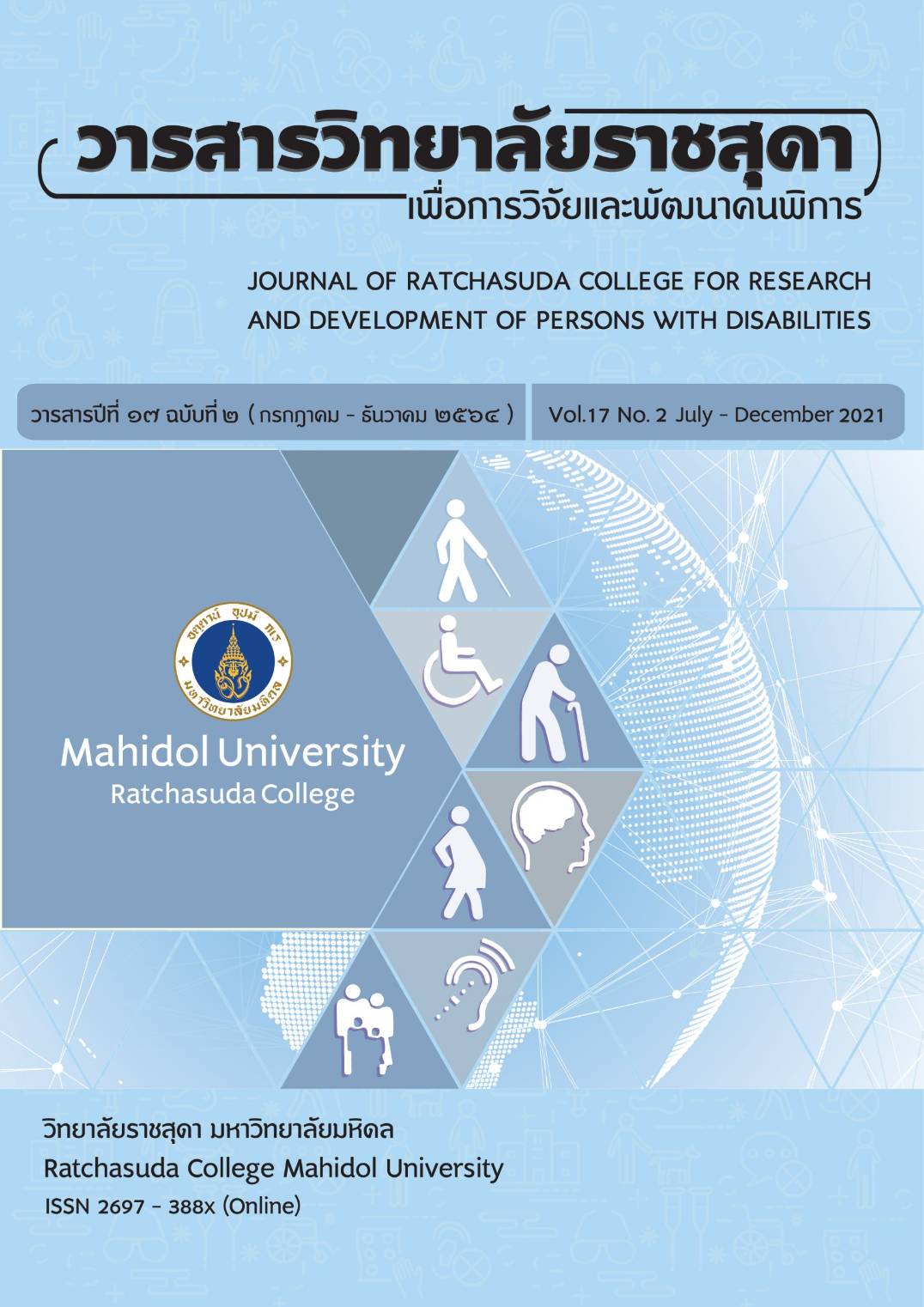Development of a Preschoolers’ Sensory Integration Disorder Screening Tool for Teachers
Keywords:
Screening Tool Development, Sensory Integration Disorder, Preschooler, TeacherAbstract
This developmental research aimed to develop impairment screening tool on Preschoolers’ Sensory Integration Disorder Screening Tool for Teachers, and to examine content validity and reliability in Preschoolers’ Sensory Integration Disorder Screening Tool for Teachers. There were 3 phases of this research as follow; first phase was planning process. The second phase was to set the structure of screening. The third phase was to examine on the sample group to find the reliability by measuring internal consistency and finding the value of Rater Agreement Index: RAI. Sample group of this research was a group of 42 teachers at Special Education Center, the supporting network on efficiency of special education management, the 8th network and used purposive sampling methods. The result was found that the Preschoolers’ Sensory Integration Disorder Screening Tool for Teachers had 43 questions. The questions were divided into 3 aspects: sensory modulation disorder, sensory discrimination disorder, and dyspraxia and had content validity from 0.67-1.00. To find the reliability, it was found that the total test had 0.73 of reliability, which was acceptable. The value for Rater Agreement Index from five raters was 1.00.
Downloads
References
Miller, L. J., Anzalone, M. E., Lane, S. J., Cermak, S. A., & Osten, E. T. (2007). Concept evolution in sensory
integration: a proposed nosology for diagnosis. The American Journal of Occupational, 61(2), 135-140.
Pasunon, P. (2015). Validity of questionnaire for social science research. Journal of Social Sciences
Srinakharinwirot University, 18(18), 380.
Phochanajan, T. (2016). The exploratory factor analysis, children’s behavior problems, the
psychometric properties. (Unpublished master’s thesis). Srinakharinwirot University, Bangkok,Thailand.
Saksiriphol, D. (2012). Screening for children with special needs. In Jansrisokot, J, (Eds.). Inclusive Education (pp. 73). Rajabhat Udon Thani.
Sangarun, S. (2011). The effectiveness of developmental screening in children age of 2,4,9 and 15
month by anamai 49 compared with denver II. Department of Pediatrics, Queen Sirikit National
Institute of Child Health, Bangkok, Thailand.
Schaaf, R. C., & Roley, S. S. (2006). SI: Applying clinical reasoning to practice with diverse populations.
San Antonio.TX: Harcourt Assessment.
Thavornpaiboonbut, N. (2010). Construct validity of the praxis subtest of the sensory integration and
praxis tests: Thai version. (Unpublished master’s thesis). Chiang Mai University, Chiang Mai, Thailand.
Tongsokdee, R., Vittayakorn, S., Leosiripong, P.,Tongthaworn, R., Somnam, S., & Thipkasorn, S. (2018).
Teaching modifications and accommodations for students with learning disabilities in elementary inclusive classrooms. Chiang Mai University, Chiang Mai, Thailand.
Vittayakorn, S., Chinchai, S., & Sriphetcharawut, S. (2012). Sensory integration frame of reference:
Theory and clinical practice in occupational therapy. Chiang Mai: Nana Press.
Whandang, T. (2009). The pilot study of sensory modulation disorder assessment tools using the
infant/toddler symptom checklist aged 7-30 months : Thai version. (Unpublished master’s thesis). Chiang Mai University, Chiang Mai, Thailand.
Ziviani, J., Rodger, S., Pacheco, P., Rootsey, L., Smith, A., & Katz, N. (2004). The dynamic occupational
therapy cognitive assessment for children (DOTCA Ch) : Pilot study of inter-rater and test retest
reliability. New Zealand Journal of Occupational Therapy, 51(2), 17-24
Downloads
Published
How to Cite
Issue
Section
License
Copyright (c) 2021 JOURNAL OF RATCHASUDA COLLEGE FOR RESEARCH AND DEVELOPMENT OF PERSONS WITH DISABILITIES

This work is licensed under a Creative Commons Attribution-NonCommercial-NoDerivatives 4.0 International License.
บทความที่ได้รับการตีพิมพ์เป็นลิขสิทธิ์ของวารสารสถาบันราชสุดาเพื่อการวิจัยและพัฒนาคนพิการ






